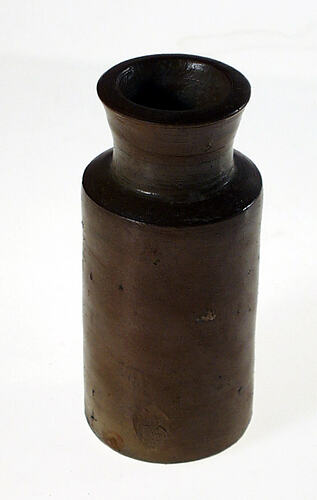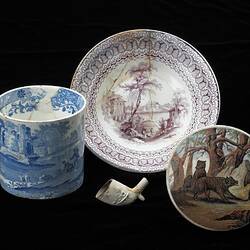Summary
This salt-glazed ceramic blacking bottle was excavated at the Commonwealth Block site between 1988 and 2003. Blacking was used for cleaning stoves or other household items. It was possibly manufactured by Lithgow or Bendigo Potteries during the 1870s.
Food and eating.
Kitchen facilities in the homes of Little Lon were rudimentary. Few people had ovens or ice chests, so perishable foods were bought fresh daily. Most meals were fried or boiled over an open fire. Families with limited facilities would take their Sunday roasts to a nearby bakery for cooking. Even the poorest residents of Little Lon seem to have eaten a considerable amount of meat. Mutton, beef, rabbit and pork came from the Eastern Market in Bourke Street. Oysters and fish were sold from barrows in Flinders Street. Fresh fruit and vegetables were hawked on the streets by Chinese and Italian vendors.
Physical Description
This is a salt-glazed stoneware jar. It has a graduated glaze colour and is unglazed inside. The base, body. shoulder, neck and lid are wheel thrown.
Physical Description
Salt-glazed stoneware jar - complete. Graduated glaze colour, unglazed inside. 15.5 cm. Wheel - thrown, base, body. shoulder, neck and lid. The jar is unmarked. Possibly Lithgow or Bendigo. (Bendigo Pottery was unmarked until the 1880s.) Known as a 'blacking bottle' - contained blacking for stove or other household cleansing liquids; probably not for food. possibly made in the 1870s. Reference: Scoles, 1979.
More Information
-
Collection Names
-
Collecting Areas
-
Acquisition Information
Transfer from Heritage Victoria, Industry Superannuation Property Trust, 03 May 2005
-
Context Number
04/29
-
Site
[CCS] Australia, Victoria, Commonwealth Block, Melbourne
-
Activity
-
Classification
-
Category
-
Discipline
-
Type of item
-
Exhibition Collection Management
70 mm (Width), 155 mm (Height)
Width = Diameter
-
Keywords


